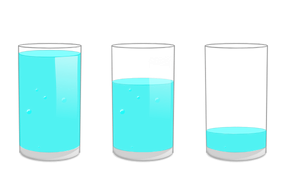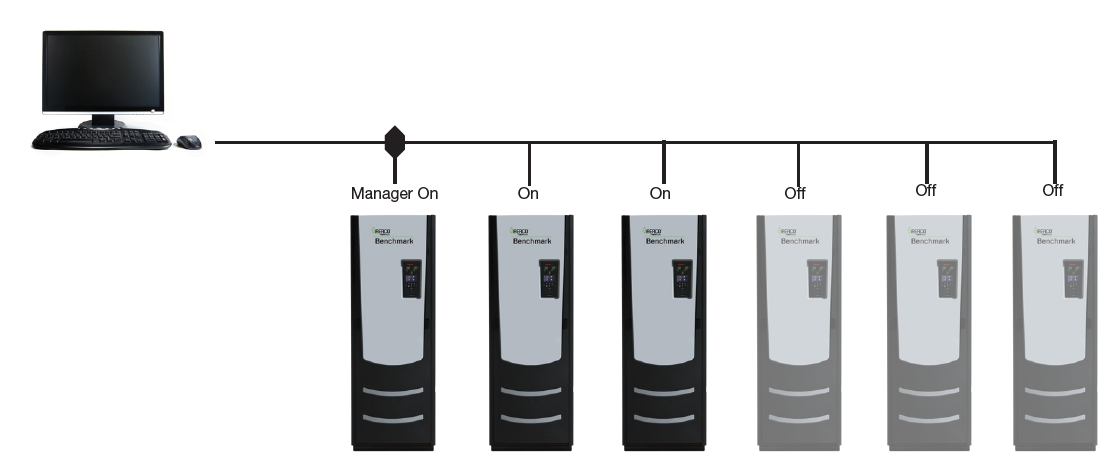
Many hydronic heating systems that use condensing boilers are designed with primary variable pumping. In this type of system, the flow rate through the terminal units and any bypasses adds up to the flow through the boiler plant. This type of system adds complexity to the condensing boiler operation which the engineer should understand when designing the system.
What is Primary Variable vs. Primary-Secondary?
Let’s level set on definitions before we get into the key concerns in a boiler plant. I understand this is basic and feel free to skip this section. The difference between the two pumping system types is outlined in the Condensing Fire-tube Boiler Heating System and Primary-Secondary Pumping blog under the title, “A Quick Review of Hydronic Boiler Piping Schemes”.
The key difference is how the flow rate through the boiler is accomplished. In the primary-secondary system, there is a dedicated circulator pump for boiler and a separate main pump for the system. In the primary variable system, the main pump which moves water to the terminal units will also determine the flow rate in the boiler plant.
There are three key design considerations for the engineer.
Point #1: Avoiding Flow Through a Non-Operational Boiler

Part three of this series, Condensing Boiler Specification: Operation at Lower Loads, described the advantages of running multiple boilers at less than full load. There are, of course, times when a boiler is not online. Times where we may only be expecting to operate a single boiler. We want to avoid water circulation through a boiler that is not operational.
Many state energy codes follow the ASHRAE 90.1 standards. One of the standards concerns the energy wasted by circulating water through a boiler that is not operational. In a primary variable system, this is accomplished using on-off two-way valves at each boiler. One example of this code is in Michigan, Michigan Rolls ASHRAE 90.1-2013 into the 2015 Michigan Energy Code. Check your State and local code to see what the requirements are for your project.
You may still want to use the two-way control valves in a primary variable system even if the code does not require them. Without the valves to stop flow in the non-operational boilers, you will experience mixing hot supply water with return water.
The on-off control valves should operate very slowly. It would not be an exaggeration to say we want a few minutes from open to close and vice versa. The comfort heating system does not normally have instantaneous load changes such as a plumbing system might.
The slow-acting valves will prevent the flow in the operating boiler from dropping instantaneously which could cause burner or safety control issues. Remember, for two boilers, the flow rate will be half in each boiler once the valves are both open. If the flow rate was, for example, 100 GPM in one boiler, the system heat load did not change when a second boiler cycled on. The flow rate in the two boilers would now be half or 50 GPM. The boiler that was operating will need to adjust to this change.
Point #2: The System Must Provide Enough Flow Rate to Meet the Minimum Boiler Requirements
 Our blog, Condensing Fire-tube Boiler Heating System and Primary-Secondary Pumping mentioned above starts to examine the minimum flow rate required by the boiler.
Our blog, Condensing Fire-tube Boiler Heating System and Primary-Secondary Pumping mentioned above starts to examine the minimum flow rate required by the boiler.
The primary variable sketch at the beginning of this blog shows a three-way control valve at the end terminal unit. We would suggest multiple three-way valves at the end of each loop in various directions of the system. This will keep the water in the mains at supply temperature as well as helping any minimum flow rate issue.
The blog, Solving Minimum Flow in a Primary Variable System (Part 3), offers a few options for providing the boiler plant with the required minimum flow rate without the use of three way-valves at some terminal units.
What is the minimum flow rate we need to create? It must satisfy the minimum flow rate required by the pump. In a variable speed application, the pump is normally not the controlling issue although the calculation must be done. The boiler minimum flow rate must be met. If more than one boiler is operating, the minimum flow rate of all boilers operating must be met. Here you need to review your sizing and safety factors. Did you grossly oversize the system? Did you design it for future load? In an old existing system, are the terminal units grossly oversized due to changes in windows and insulation? These rare things may play into your decision.
Can you have too much minimum flow rate? If you are bypassing hot water back to the boiler plant, there will be some elevation of the return water. Too much of this may cause cycling of the boilers which adds to the wear and tear as well as negatively impacting energy cost.
My good friend, Dan Holtmeyer of the Verne Simmonds Company in Omaha, often preaches this concern. He recommends in new systems that the cycle count be reviewed. If the bypass valves are causing too much cycling, the reset schedule should be changed, and the supply water temperature dropped. This will cause the terminal control valves to open more and satisfy minimum flows in this preferred way. Good advice from my friend.
Point #3: Staging Boilers, Temperature Reset, Control Valve Position, and Cycling Concerns
My third point is recognizing the complexity of all these balls in the air. A great boiler controller and involvement of the boiler supplier is key to the lowest operating cost for your client. The great boiler controller should do all the things the Aerco Edge Controller does and still be easy enough for the owner or your service contractor to operate without hiring an IT person to manage or make changes.
The engineer may advise the owner to have the boiler supplier come out after the first season of operation to tweak the system based on the copious information available through the Edge Controller. It would be tough to have this in the contract documents with such a large time delay, but the expected costs could be discussed with the supplier at the time of design.
What if there are many unknowns about these three points? Stay tuned for next week’s R. L. Deppmann Monday Morning Minutes.
Part 1: Condensing Boiler Specification – Part 1 – Design Efficiency
Part 2: Condensing Boiler Specification – Part 2 –Boiler Temperature Reset Made Simple?
Part 3: Condensing Boiler Specification – Part 3 – Operation at Lower Loads


